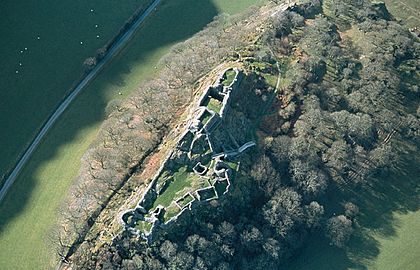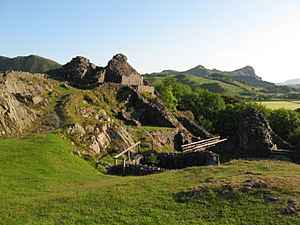Castell y Bere facts for kids
Quick facts for kids Castell y Bere |
|
|---|---|
| Llanfihangel-y-pennant, Wales | |

Castell y Bere
|
|
| Coordinates | 52°39′29″N 3°58′17″W / 52.65818°N 3.9715°W |
| Type | Linear castle |
| Site information | |
| Owner | Cadw |
| Condition | Ruined |
| Site history | |
| Built | Began 1221 |
| Built by | Llywelyn the Great |
| In use | Open to public |
| Materials | Siltstone |
| Events | Welsh Wars Prince Madoc's Rebellion |
Castell y Bere is a historic Welsh castle. It is located near Llanfihangel-y-pennant in Gwynedd, Wales. Llywelyn the Great, a powerful Welsh prince, started building it in the 1220s. The stone castle helped him control the local people. It also defended the southwest part of his princedom, Gwynedd. In 1282, a war with Edward I of England led to the death of Llywelyn's grandson, Llywelyn ap Gruffudd. Castell y Bere then fell to English forces. King Edward I made the castle bigger and built a small town next to it. But in 1294, a Welsh leader named Madog ap Llywelyn started a big rebellion. The castle was attacked and seems to have been burned. Edward I did not repair it, and it became a ruin. Today, Cadw looks after the castle. It is a popular place for visitors.
Contents
History of Castell y Bere
Building the Castle (1220–1240)
Castell y Bere was built in the 1220s. Llywelyn the Great chose a rocky hill overlooking the Dysynni Valley. This spot was near Llanfihangel-y-pennant. Welsh princes usually did not build castles. They used open palaces called llysoedd, or courts.
From the late 1000s, the Normans had moved into Wales. They took land in the north. They also created a controlled area in the south called the Welsh Marches. By the 1100s, some timber and earth castles were built, but not many.
Llywelyn the Great first ruled only Gwynedd. But he became much more powerful during his reign. He gained control over most of Wales in the early 1200s. Llywelyn faced challenges. He had to deal with threats from the kings of England. He also needed to keep control over the Welsh people.
In 1221, Llywelyn took control of Meirionnydd from his son, Gruffydd. They had a disagreement. The prince then began building Castell y Bere. He wanted to control the people there. He also wanted to protect his new southwest border. This border included mountain trade routes. These routes connected Gwynedd, Powys Wenwynwyn, and Deheubarth. Castell y Bere was the first stone castle Llywelyn built. The first castle had several towers around a courtyard. It was on a rocky hill in the Dysynni Valley near Cadair Idris.
English Control and Rebellion (1240–1300)
After Llywelyn died in 1240, Gwynedd's power lessened. Henry III of England took many of its eastern lands in 1247. Llywelyn's grandson, Llywelyn ap Gruffudd, became ruler in 1255. He imprisoned his brother Owain ap Gruffudd. Then he expanded his power across Wales. Llywelyn added a new tower to the south of the castle. This tower was similar to one at Dolforwyn Castle. It probably provided more living space.
The fighting between Welsh princes and English kings continued. This happened during the time of Edward I. In 1282, Llywelyn fought his last battle against Edward. He died near Builth in December. His brother, Dafydd ap Gruffydd, took over. But in 1283, he was forced south into Snowdonia.
Meanwhile, English forces attacked Castell y Bere. They were led by Roger Lestrange and William de Valence. They came from south Wales and Shropshire. They surrounded the castle and took it on April 25. Edward sent 7,000 soldiers to capture Dafydd. Dafydd was finally caught and executed in October. After the English army left, a team of workers stayed at Castell y Bere. They included five masons (stone workers) and five carpenters. They were led by Master Bertram the Engineer. They were there "to carry out various works." Historians believe they repaired the castle after the attack.
King Edward I continued to spend money on Castell y Bere. He visited three times in 1284. He also built a small town next to the castle, possibly to the east. Walter of Huntercombe became the castle's constable (manager) in 1284. He spent £47 building a new room there. This room might have been for the king to use during his visits. Another £262 was spent between 1286 and 1290. Most of this was after the revolt of Rhys ap Maredudd. Two connecting walls to the south tower were likely built around this time. The outer barbican (a fortified gatehouse) and gate towers might also have been built then.
However, in 1294, the Welsh leader Madoc ap Llywelyn started a big rebellion across Wales. Richard Fitzalan, the Earl of Arundel, was told to make sure the castle was safe. But by late October, Madoc's forces were attacking the castle. Robert FitzWalter, the castle's constable, was sent to help. We are not sure what happened to Castell y Bere in the end. But it was probably taken by Welsh forces in late 1294 and then burned.
Later Years (14th–21st Century)
After the rebellion, Castell y Bere and the new English town were both left empty. The castle was in a good location. But unlike other new castles built by Edward I, it could not get supplies by sea. This meant it did not fit well into his plans for controlling North Wales. By the 1500s, the castle was falling apart. The Welsh poet Gruffydd Hiraethog wrote about it. He said that Castell-y-Bere, once a strong building, was now "destroyed and cast to the ground."
After many years, the site was finally cleared of plants in the 1850s. This showed more of the castle's remains. William Wynne, who owned the site, did the first archaeological digs. In 1949, Charles Corbett, the last private owner, gave the ruins to the state. In the 21st century, Cadw cares for the site. It is a scheduled monument (a protected historical site). It is also a tourist attraction. With recent changes in how Wales is governed, the history of Welsh castles like Castell y Bere has become more important. Cadw plans to focus more on sharing the history of these castles and the Welsh princes.
Castle Design and Features
Today, the ruins of Castell y Bere stand on a rocky hill. There are protective ditches cut into the stone on the south and east sides. The castle entrance is on the west side. Here, the barbican (a fortified entrance), likely built by Edward I, has two gate towers. They look over the stone steps leading to the inner gate. Past the barbican is the castle courtyard. It has a large well and the remains of several buildings. We don't know exactly when these buildings were made.
The north tower has a "D-shaped" design. This shape is common in Welsh castles from the early 1200s. It might have held a hall or a chapel. What is now the middle tower was once the southernmost part of the defenses. It now leads through the Edwardian ditch yard to the south tower. This is another D-shaped tower. It once had large living spaces. Both D-shaped towers did not have fireplaces in their main rooms. Instead, they used central fires to heat the rooms.

It is unusual for an early Welsh castle, but there is evidence of decorative carvings. These include statues of soldiers built into the castle. There were also decorative floor tiles. Castell y Bere is the only castle, besides Criccieth, to have such features. Historian Lawrence Butler believes the castle has some of the "finest stone carving from thirteenth-century Wales."





